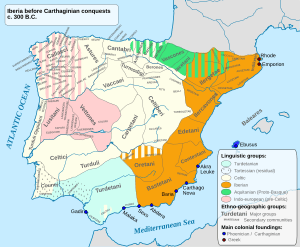Olcades facts for kids
The Olcades were an ancient group of people who lived in Hispania (which is modern-day Spain) a long time before the Romans arrived. They were mainly involved in raising animals. They lived in the southeastern part of the Iberian system mountains, to the west of another group called the Turboletae.
Contents
Who Were the Olcades?
The Olcades were connected to both the Celtiberians and the Carpetani. It seems they were a mix of local Iberians and a ruling class of Gallic (French) origin. Many historians believe these Gallic rulers came from the Volcae Tectosages tribe in southern Gaul. They arrived in Iberia during the Celtic migrations in the 4th century BC.
Where Did They Live?
From the 4th century BC, the Olcades lived in most of what is now the Province of Cuenca. They also occupied the southern part of Guadalajara and the western edge of Valencia.
Their main city was called Cartala. Today, this site is near Caudete de las Fuentes. Other important Olcades towns included Caesada (near Hita), Ercavica (near Cañaveruelas), Ikalkusken (near Arcas), and Laxta (possibly Iniesta).
Olcades Culture
Archaeologists have found many clues about the Olcades' culture in places like the cemeteries of Buenache and Olmedilla de Alarcón. These findings show that the Olcades were greatly influenced by traders from the south of Iberia, Phoenicia, Etruria, and Greece.
In fact, the Olcades are thought to have helped spread the 'Iberian' culture to their neighbors, the Celtiberians and Carpetani, during the second Iron Age.
Olcades History
In 221 BC, the Olcades, led by their King Tagus, formed an alliance with the Vaccaei and Carpetani. They wanted to stop the Carthaginians from expanding into their lands. However, they were defeated by the famous general Hannibal Barca at the Battle on the Tagus in 220 BC.
After this defeat, Hannibal forced the Olcades to join his army as mercenary troops. The Greek historian Polybius wrote that Hannibal sent Olcades soldiers to Africa in 218 BC.
Changing Sides
When Hannibal left for Italy to fight the Romans in the Second Punic War, the Olcades changed their minds. They decided to fight alongside the Romans for the rest of the war.
Even though the Romans included them in the province of Hispania Citerior around 156–154 BC, the Olcades remained loyal to Rome. They successfully defended themselves against attacks from the Lusitani tribe, led by Viriathus, in the mid-2nd century BC.
Becoming Part of Rome
The Olcades managed to stay independent until the late 2nd or early 1st centuries BC. For reasons that are not fully clear, Rome then took away their tribal lands.
In 92 BC, the Roman Praetor (a high-ranking official) Gaius Valerius Flaccus founded a military settlement called Valeria (near Las Valeras) on Olcadian territory. He had won a big victory over the Celtiberians the year before. He also divided the Olcades' land among Rome's allies, the Edetani and Celtiberians. This forced the Olcades to merge with the Celtiberians.
See also
 In Spanish: Olcades para niños
In Spanish: Olcades para niños
- Carpetani
- Celtiberian script
- Edetani
- Vaccaei
- Volcae Tectosages
- Northeastern Iberian script
- Pre-Roman peoples of the Iberian Peninsula


